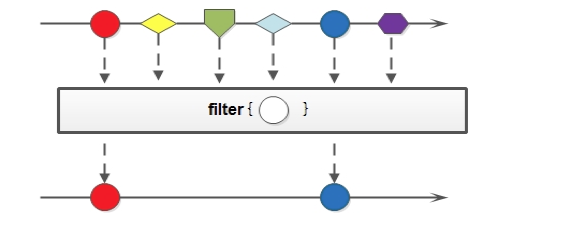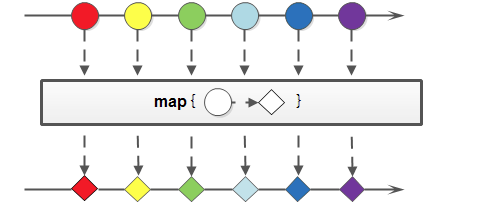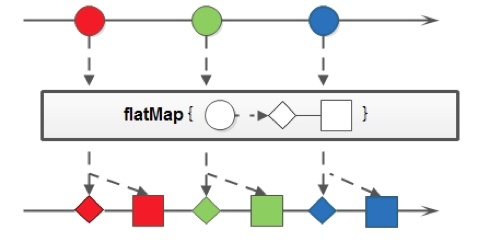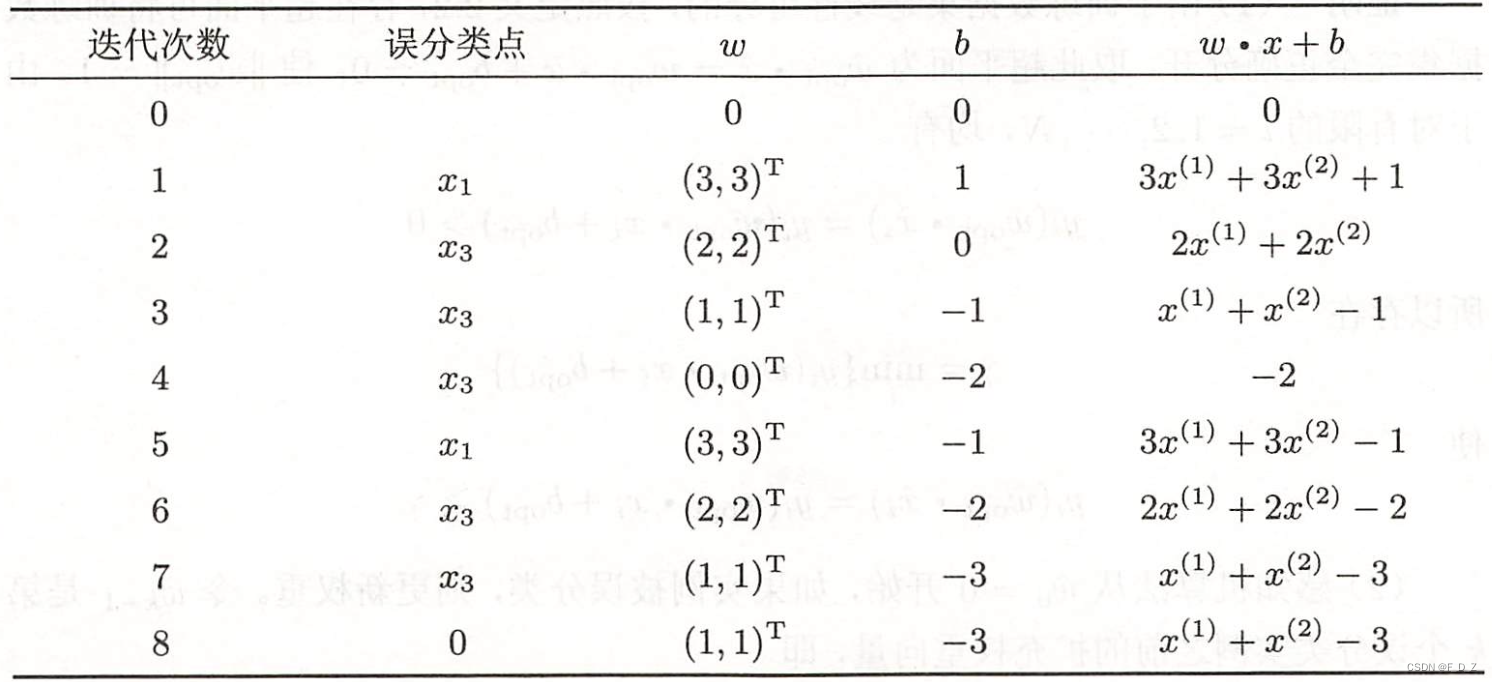Java 8 stream的使用示例
一、概述Stream 是 Java8 中处理集合的关键抽象概念,它可以指定你希望对集合进行的操作,可以执行非常复杂的查找、过滤和映射数据等操作。使用Stream API 对集合数据进行操作,就类似于使用 SQL 执行的数据库查询。也可以使用 Stream API 来并行执行操作。简而言之,Stream API 提供了一种高效且易于使用的处理数据的方式。特点:元素是特定类型的对象,形成一个队列。 J
一、概述
Stream 是 Java8 中处理集合的关键抽象概念,它可以指定你希望对集合进行的操作,可以执行非常复杂的查找、过滤和映射数据等操作。使用Stream API 对集合数据进行操作,就类似于使用 SQL 执行的数据库查询。也可以使用 Stream API 来并行执行操作。简而言之,Stream API 提供了一种高效且易于使用的处理数据的方式。
特点:
- 元素是特定类型的对象,形成一个队列。 Java中的Stream并不会存储元素,而是按需计算。
- 数据源 流的来源。 可以是集合,数组,I/O channel, 产生器generator 等。
- 聚合操作 类似SQL语句一样的操作, 比如filter, map, reduce, find, match, sorted等。
- Pipelining: 中间操作都会返回流对象本身。 这样多个操作可以串联成一个管道, 如同流式风格(fluent style)。 这样做可以对操作进行优化, 比如延迟执行(laziness)和短路( short-circuiting)。
- 内部迭代: 以前对集合遍历都是通过Iterator或者For-Each的方式, 显式的在集合外部进行迭代, 这叫做外部迭代。 Stream提供了内部迭代的方式, 通过访问者模式(Visitor)实现。
二、分类

无状态:指元素的处理不受之前元素的影响;
有状态:指该操作只有拿到所有元素之后才能继续下去。
非短路操作:指必须处理所有元素才能得到最终结果;
短路操作:指遇到某些符合条件的元素就可以得到最终结果,如 A || B,只要A为true,则无需判断B的结果。
三、具体用法
1.流的常用创建方法
1.1 使用Collection下的 stream() 和 parallelStream() 方法
List<String> list = new ArrayList<>();
Stream<String> stream = list.stream(); //获取一个顺序流
Stream<String> parallelStream = list.parallelStream(); //获取一个并行流
1.2 使用Arrays 中的 stream() 方法,将数组转成流
Integer[] nums = new Integer[10];
Stream<Integer> stream = Arrays.stream(nums);
1.3 使用Stream中的静态方法:of()、iterate()、generate()
Stream<Integer> stream = Stream.of(1,2,3,4,5,6);
Stream<Integer> stream2 = Stream.iterate(0, (x) -> x + 2).limit(6);
stream2.forEach(System.out::println); // 0 2 4 6 8 10
Stream<Double> stream3 = Stream.generate(Math::random).limit(2);
stream3.forEach(System.out::println);
1.4 使用 BufferedReader.lines() 方法,将每行内容转成流
BufferedReader reader = new BufferedReader(new FileReader("F:\\test_stream.txt"));
Stream<String> lineStream = reader.lines();
lineStream.forEach(System.out::println);
1.5 使用 Pattern.splitAsStream() 方法,将字符串分隔成流
Pattern pattern = Pattern.compile(",");
Stream<String> stringStream = pattern.splitAsStream("a,b,c,d");
stringStream.forEach(System.out::println);
2. 流的中间操作
2.1 筛选与切片(分页、交并集)
- filter:过滤流中的某些元素
- limit(n):获取n个元素
- skip(n):跳过n元素,配合limit(n)可实现分页
- distinct:通过流中元素的 hashCode() 和 equals() 去除重复元素

// 去重、跳过、限制
Stream<Integer> stream = Stream.of(6, 4, 6, 7, 3, 9, 8, 10, 12, 14, 14);
10 12 14 14
.distinct() //6 7 9 8 10 12 14
.skip(2) //9 8 10 12 14
.limit(2); //9 8
newStream.forEach(System.out::println);
Stream<Integer> newStream = stream.filter(s -> s > 5) //6 6 7 9 8
// 分页
vos.stream()
.skip(pageable.getPageSize() * (pageable.getPageNumber() - 1))
.limit(pageable.getPageSize()).collect(Collectors.toList());
List<String> list1 = new ArrayList<String>();
List<String> list2 = new ArrayList<String>();
// 交集
List<String> intersection = list1.stream().filter(item -> list2.contains(item)).collect(toList());
// 差集 (list1 - list2)
List<String> reduce1 = list1.stream().filter(item -> !list2.contains(item)).collect(toList());
// 差集 (list2 - list1)
List<String> reduce2 = list2.stream().filter(item -> !list1.contains(item)).collect(toList());
// 并集
List<String> listAll = list1.parallelStream().collect(toList());
List<String> listAll2 = list2.parallelStream().collect(toList());
listAll.addAll(listAll2);
// 去重并集
List<String> listAllDistinct = listAll.stream().distinct().collect(toList());
使用List方法
| 需求 | list的方法 | 说明 | 备注 |
|---|---|---|---|
| 交集 | listA.retainAll(listB) | listA内容变为listA和listB都存在的对象 | listB不变 |
| 差集 | listA.removeAll(listB) | listA中存在的listB的内容去重 | listB不变 |
| 并集 | listA.removeAll(listB) listA.addAll(listB) |
为了去重,listA先取差集,然后追加全部的listB | listB不变 |
/**************List方法****************/
// 交集:[A,B]∩[B,C]
listA_01.retainAll(listB_01);
System.out.println(listA_01); // 结果:[B]
System.out.println(listB_01); // 结果:[B, C]
// 差集:[A,B]-[B,C]
listA_02.removeAll(listB_02);
System.out.println(listA_02); // 结果:[A]
System.out.println(listB_02); // 结果:[B, C]
// 并集:[A,B]U[B,C]
listA_03.removeAll(listB_03);
listA_03.addAll(listB_03);
System.out.println(listA_03); // 结果:[A, B, C]
System.out.println(listB_03); // 结果:[B, C]
如果集合存在重复元素,由于使用的是List的contains方法过滤,并不能得到正确结果
如差集 list1[A,B,B] - list2[A,B],会得到空集,可以使用以下方法
List<String> finalDisSpuIds = new ArrayList<>();
List<String> repeatSpu = new ArrayList<>();
for (String spuId:spuIds){
if (finalDisSpuIds.contains(spuId)){
repeatSpu.add(spuId);
}
else {
finalDisSpuIds.add(spuId);
}
}
2.2 映射
- map:接收一个函数作为参数,该函数会被应用到每个元素上,并将其映射成一个新的元素。
- flatMap:接收一个函数作为参数,将流中的每个值都换成另一个流,然后把所有流连接成一个流。


List<String> list = Arrays.asList("a,b,c", "1,2,3");
//将每个元素转成一个新的且不带逗号的元素
Stream<String> s1 = list.stream().map(s -> s.replaceAll(",", ""));
s1.forEach(System.out::println); // abc 123
Stream<String> s3 = list.stream().flatMap(s -> {
//将每个元素转换成一个stream
String[] split = s.split(",");
Stream<String> s2 = Arrays.stream(split);
return s2;
});
s3.forEach(System.out::println); // a b c 1 2 3
2.3 排序
- sorted():自然排序,流中元素需实现Comparable接口
- sorted(Comparator com):定制排序,自定义Comparator排序器
List<String> list = Arrays.asList("aa", "ff", "dd");
//String 类自身已实现Compareable接口
list.stream().sorted().forEach(System.out::println);// aa dd ff
// 按年龄升序排序(Integer类型)
vos.stream().sorted(Comparator.comparing(Student::getAge)).collect(Collectors.toList());
// 按年龄降序排序
vos.stream().sorted(Comparator.comparing(Student::getAge).reversed()).collect(Collectors.toList());
// 年龄降序排序,年龄相同再身高升序排序
vos.stream().sorted(Comparator.comparing(Student::getAge).reversed()
.thenComparing(Student::getHeight)).collect(Collectors.toList());
Student s1 = new Student("aa", 10);
Student s2 = new Student("bb", 20);
Student s3 = new Student("aa", 30);
Student s4 = new Student("dd", 40);
List<Student> studentList = Arrays.asList(s1, s2, s3, s4);
//自定义排序:先按姓名升序,姓名相同则按年龄升序
studentList.stream().sorted(
(o1, o2) -> {
if (o1.getName().equals(o2.getName())) {
return o1.getAge() - o2.getAge();
} else {
return o1.getName().compareTo(o2.getName());
}
}
).forEach(System.out::println);
2.4 消费
- peek:如同于map,能得到流中的每一个元素。但map接收的是一个Function表达式,有返回值;而peek接收的是Consumer表达式,没有返回值。
Student s1 = new Student("aa", 10);
Student s2 = new Student("bb", 20);
List<Student> studentList = Arrays.asList(s1, s2);
studentList.stream()
.peek(o -> o.setAge(100))
.forEach(System.out::println);
//结果:
Student{name='aa', age=100}
Student{name='bb', age=100}
3. 流的终止操作
3.1 匹配、聚合操作
- allMatch:接收一个 Predicate 函数,当流中每个元素都符合该断言时才返回true,否则返回false
- noneMatch:接收一个 Predicate 函数,当流中每个元素都不符合该断言时才返回true,否则返回false
- anyMatch:接收一个 Predicate 函数,只要流中有一个元素满足该断言则返回true,否则返回false
- findFirst:返回流中第一个元素
- findAny:返回流中的任意元素
- count:返回流中元素的总个数
- max:返回流中元素最大值
- min:返回流中元素最小值
List<Integer> list = Arrays.asList(1, 2, 3, 4, 5);
boolean allMatch = list.stream().allMatch(e -> e > 10); //false
boolean noneMatch = list.stream().noneMatch(e -> e > 10); //true
boolean anyMatch = list.stream().anyMatch(e -> e > 4); //true
Integer findFirst = list.stream().findFirst().get(); //1
Integer findAny = list.stream().findAny().get(); //1
long count = list.stream().count(); //5
Integer max = list.stream().max(Integer::compareTo).get(); //5
Integer min = list.stream().min(Integer::compareTo).get(); //1
3.2 规约操作
- Optional<T> reduce(BinaryOperator<T> accumulator):第一次执行时,accumulator函数的第一个参数为流中的第一个元素,第二个参数为流中元素的第二个元素;第二次执行时,第一个参数为第一次函数执行的结果,第二个参数为流中的第三个元素;依次类推。
- T reduce(T identity, BinaryOperator<T> accumulator):流程跟上面一样,只是第一次执行时,accumulator函数的第一个参数为identity,而第二个参数为流中的第一个元素。
- <U> U reduce(U identity,BiFunction<U, ? super T, U> accumulator,BinaryOperator<U> combiner):在串行流(stream)中,该方法跟第二个方法一样,即第三个参数combiner不会起作用。在并行流(parallelStream)中,我们知道流被fork join出多个线程进行执行,此时每个线程的执行流程就跟第二个方法reduce(identity,accumulator)一样,而第三个参数combiner函数,则是将每个线程的执行结果当成一个新的流,然后使用第一个方法reduce(accumulator)流程进行规约。
//经过测试,当元素个数小于24时,并行时线程数等于元素个数,当大于等于24时,并行时线程数为16
List<Integer> list = Arrays.asList(1, 2, 3, 4, 5, 6, 7, 8, 9, 10, 11, 12, 13, 14, 15, 16, 17, 18, 19, 20, 21, 22, 23, 24);
Integer v = list.stream().reduce((x1, x2) -> x1 + x2).get();
System.out.println(v); // 300
Integer v1 = list.stream().reduce(10, (x1, x2) -> x1 + x2);
System.out.println(v1); //310
Integer v2 = list.stream().reduce(0,
(x1, x2) -> {
System.out.println("stream accumulator: x1:" + x1 + " x2:" + x2);
return x1 - x2;
},
(x1, x2) -> {
System.out.println("stream combiner: x1:" + x1 + " x2:" + x2);
return x1 * x2;
});
System.out.println(v2); // -300
Integer v3 = list.parallelStream().reduce(0,
(x1, x2) -> {
System.out.println("parallelStream accumulator: x1:" + x1 + " x2:" + x2);
return x1 - x2;
},
(x1, x2) -> {
System.out.println("parallelStream combiner: x1:" + x1 + " x2:" + x2);
return x1 * x2;
});
System.out.println(v3); //197474048
3.3 收集操作
collect:接收一个Collector实例,将流中元素收集成另外一个数据结构。
Collector<T, A, R> 是一个接口,有以下5个抽象方法:
- Supplier<A> supplier():创建一个结果容器A
- BiConsumer<A, T> accumulator():消费型接口,第一个参数为容器A,第二个参数为流中元素T。
- BinaryOperator<A> combiner():函数接口,该参数的作用跟上一个方法(reduce)中的combiner参数一样,将并行流中各个子进程的运行结果(accumulator函数操作后的容器A)进行合并。
- Function<A, R> finisher():函数式接口,参数为:容器A,返回类型为:collect方法最终想要的结果R。
- Set<Characteristics> characteristics():返回一个不可变的Set集合,用来表明该Collector的特征。有以下三个特征:
- CONCURRENT:表示此收集器支持并发。(官方文档还有其他描述,暂时没去探索,故不作过多翻译)
- UNORDERED:表示该收集操作不会保留流中元素原有的顺序。
- IDENTITY_FINISH:表示finisher参数只是标识而已,可忽略。
3.3.1 Collector 工具库:Collectors
Student s1 = new Student("aa", 10,1);
Student s2 = new Student("bb", 20,2);
Student s3 = new Student("cc", 10,3);
List<Student> list = Arrays.asList(s1, s2, s3);
//装成list
List<Integer> ageList = list.stream().map(Student::getAge).collect(Collectors.toList()); // [10, 20, 10]
//转成set
Set<Integer> ageSet = list.stream().map(Student::getAge).collect(Collectors.toSet()); // [20, 10]
//转成map,注:key不能相同,否则报错
Map<String, Integer> studentMap = list.stream().collect(Collectors.toMap(Student::getName, Student::getAge)); // {cc=10, bb=20, aa=10}
//字符串分隔符连接
String joinName = list.stream().map(Student::getName).collect(Collectors.joining(",", "(", ")")); // (aa,bb,cc)
String joinName2 = list.stream().filter(Objects::nonNull).map(Student::getName).collect(Collectors.joining(","));// aa,bb,cc
//聚合操作
//1.学生总数
Long count = list.stream().collect(Collectors.counting()); // 3
//2.最大年龄 (最小的minBy同理)
Integer maxAge = list.stream().map(Student::getAge).collect(Collectors.maxBy(Integer::compare)).get(); // 20
//3.所有人的年龄
Integer sumAge = list.stream().collect(Collectors.summingInt(Student::getAge)); // 40
//4.平均年龄
Double averageAge = list.stream().collect(Collectors.averagingDouble(Student::getAge)); // 13.333333333333334
// 带上以上所有方法
DoubleSummaryStatistics statistics = list.stream().collect(Collectors.summarizingDouble(Student::getAge));
System.out.println("count:" + statistics.getCount() + ",max:" + statistics.getMax() + ",sum:" + statistics.getSum() + ",average:" + statistics.getAverage());
// 分组
Map<Integer, List<Student>> ageMap = list.stream().collect(Collectors.groupingBy(Student::getAge));
// 多重分组,先根据类型分再根据年龄分
Map<Integer, Map<Integer, List<Student>>> typeAgeMap = list.stream().collect(Collectors.groupingBy(Student::getType, Collectors.groupingBy(Student::getAge)));
//根据多字段去重(根据年级和专业,当年级和专业都相同的情况下看做是重复数据)
List<ClassEntity> distinctClass = classEntities.stream().collect(Collectors.collectingAndThen(Collectors.toCollection(() -> new TreeSet<>(Comparator.comparing(o -> o.getProfessionId() + ";" + o.getGrade()))), ArrayList::new));
// 通过hashSet去重(如将classNames去重):该种去重是bean完全相同的时候算重复数据
List<String> classNameList = new ArrayList(new HashSet(classNames));
//分区
//分成两部分,一部分大于10岁,一部分小于等于10岁
Map<Boolean, List<Student>> partMap = list.stream().collect(Collectors.partitioningBy(v -> v.getAge() > 10));
//规约
Integer allAge = list.stream().map(Student::getAge).collect(Collectors.reducing(Integer::sum)).get(); //40
3.3.2 List根据数量分割
一个List中数量太多,需要根据每批数据限制进行分割,然后再分批使用。
import com.baomidou.mybatisplus.core.toolkit.ObjectUtils;
import lombok.extern.slf4j.Slf4j;
import org.apache.poi.ss.formula.functions.T;
import java.util.ArrayList;
import java.util.List;
import java.util.stream.Collectors;
import java.util.stream.Stream;
@Slf4j
public class BatchUtils {
private static final Integer DEFAULT_BATCH_SIZE = 500;
/**
* List分批
* @param list 需要分批的list
* @param batchNum 分批大小
* @return
*/
public static List<List<T>> batchLimit(List<T> list, int batchNum){
List<List<T>> splitList = new ArrayList<>();
if (ObjectUtils.isEmpty(list) || batchNum<1){
return splitList;
}
try{
// 分批次数
int limit = (list.size() + batchNum - 1) / batchNum;
// 根据限制的分批结果
splitList = Stream.iterate(0, n -> n + 1)
.limit(limit).parallel()
.map(num -> {
return list.stream().skip(num * batchNum).limit(batchNum).parallel().collect(Collectors.toList());
}).collect(Collectors.toList());
}catch (Exception e){
log.error("List分批异常 batchNum:"+batchNum+", list:"+list,e);
}
return splitList;
}
public static void main(String[] args) {
try{
List ids = new ArrayList<>();
ids.add(1L);ids.add(2L);ids.add(3L);
ids.add(4L);ids.add(5L);ids.add(6L);
List<List<Long>> lists = batchLimit(ids, 2);
for (List<Long> list:lists){
System.out.println(list);
}
}catch (Exception e){
log.error("",e);
}
}
}
参考:
Java 8 stream的详细用法:https://blog.csdn.net/y_k_y/article/details/84633001
Java 8 中的 Streams API 详解:https://www.ibm.com/developerworks/cn/java/j-lo-java8streamapi/
java8-Stream集合操作学习:https://www.cnblogs.com/yinjing/p/11005823.html

GitCode 天启AI是一款由 GitCode 团队打造的智能助手,基于先进的LLM(大语言模型)与多智能体 Agent 技术构建,致力于为用户提供高效、智能、多模态的创作与开发支持。它不仅支持自然语言对话,还具备处理文件、生成 PPT、撰写分析报告、开发 Web 应用等多项能力,真正做到“一句话,让 Al帮你完成复杂任务”。
更多推荐
 已为社区贡献2条内容
已为社区贡献2条内容









所有评论(0)